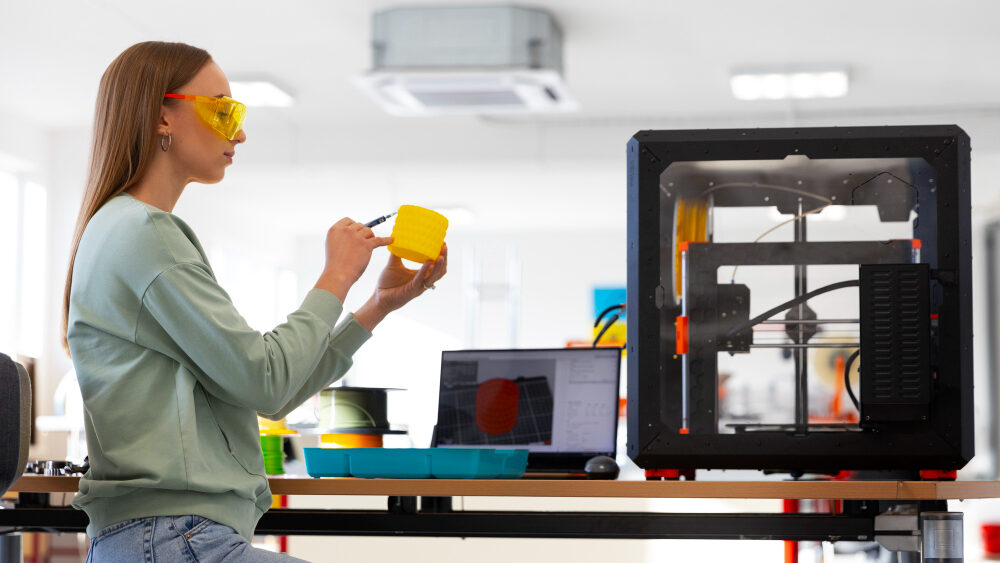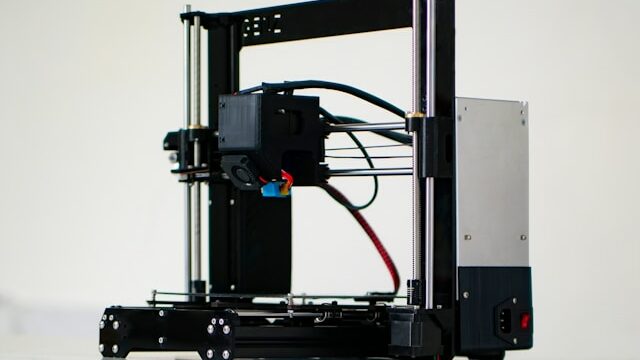Are you thinking of requesting a 3D printing quote but don’t exactly know what to ask for or under what conditions? The website Imprimy.com is here to explain how to properly create your 3D printing quote and why.
To request a 3D printing quote, you need to provide us with the prices, deadlines, and conditions of your 3D printing. You can send us an email through our contact page to provide this information, and we will get back to you as soon as possible.

Why request a quote for 3D printing?
Requesting a quote for 3D printing allows you to get a precise estimate of the costs, compare offers, know the production timelines, and ensure that the provider fully understands the project specifications.
- Why request a quote for 3D printing?
- What are the essential elements to provide for an accurate 3D printing quote?
- What are the best practices for formulating your 3D printing quote request?
- What does a 3D printing quote usually include?
- Common mistakes to avoid when requesting a 3D printing quote
- Conclusion: Requesting a 3D printing quote
- Bonus: Your template message to request a 3D printing quote
Avoid unpleasant surprises
To avoid unpleasant surprises when requesting a 3D printing quote, it is crucial to provide an accurate 3D file (usually in STL or OBJ format) along with a clear description of your expectations:
- exact dimensions
- desired material
- printing resolution
- possible finishes
- quantity
Don’t forget to ask for details about production deadlines, additional costs (such as post-processing or delivery), and the conditions for file revisions in case of issues.
Compare the providers
To compare 3D printing providers, you need to evaluate several key criteria:
- print quality
- variety of materials offered
- delivery times
- customer service responsiveness
- pricing
You can also check customer reviews, references from previous projects, and the ability to customize services according to your specific needs.
Finally, make sure the provider gives you a detailed and transparent quote, with no hidden fees, and offers technical support in case of modifications or problems with your 3D printing files.
Adapt your project to your budget
To adapt your 3D printing project to your budget, start by clearly defining your priorities: functionality, aesthetics, or deadline. You can then optimize your 3D file by reducing the dimensions, simplifying the geometry, or adjusting the wall thickness to decrease the amount of material used. Choosing a more affordable material, limiting finishes, or opting for a standard resolution can also reduce costs.
Don’t hesitate to ask the provider for advice to identify possible trade-offs while keeping the essential aspects of your project. A flexible and well-informed approach will allow you to respect your budget without sacrificing quality.
What are the essential elements to provide for an accurate 3D printing quote?
To get an accurate 3D printing quote, you need to provide the 3D file, the material, the printing technology, the dimensions, the quantity, the finishes, and the desired deadlines.
Your 3D file
Your 3D file is the foundation of any 3D printing project, so it must be precise, complete, and adapted to the chosen printing process. Make sure it is in the correct format (usually STL, OBJ, or 3MF) and respects the exact desired dimensions. The model must be watertight (without holes or mesh errors), have a sufficient minimum wall thickness for printing, and avoid details that are too fine for the machine’s resolution.
A well-prepared file reduces the risk of rework, avoids extra costs, and guarantees a result faithful to your expectations. Also, remember to name and organize your files clearly to facilitate communication with the provider.
Dimensions and scale of your 3D print
The dimensions and scale of your 3D print are crucial elements to define precisely to ensure a result that meets your expectations. It is essential to verify that your 3D file is designed at the correct scale (often in millimeters) and that the actual measurements match what you want to achieve. A scale error can result in an unusable part or unnecessary extra costs.
Additionally, consider the printing volume limits of the machine used by the provider: if your model is too large, it will need to be divided into multiple parts or resized, which can affect the strength or appearance. Careful verification upfront will save you from costly adjustments or delays.
The type of material you want to print
The type of material you choose for 3D printing has a direct impact on the cost, strength, finish, and functionality of your part. It is essential to select it based on your specific needs:
- Plastics like PLA or ABS are ideal for prototypes or everyday objects.
- PETG, nylon, or technical resins offer more strength, flexibility, or thermal resistance.
- For advanced mechanical or aesthetic uses, you can consider composite or metallic materials.
Be sure to ask the provider for advice on the technical characteristics, printing limitations, and possible finishes depending on the chosen material to ensure a result that is both functional and cost-effective.
The 3D printing technology you want to use
The 3D printing technology you choose depends directly on your project, your budget, and the properties desired for the final part. The most common technologies include:
- FDM (Fused Deposition Modeling), ideal for prototypes and simple parts at a low cost;
- Resin (SLA/DLP), perfect for detailed objects with excellent surface finish;
- SLS (Selective Laser Sintering), suited for solid technical parts without the need for supports;
- Metal fusion for very robust industrial applications.
Each technology has its advantages, constraints, and specific costs, so it is crucial to compare them carefully and discuss with the provider to choose the most suitable option for your goals.
The quantity of objects to print in 3D and your printing deadlines
The quantity of objects to print in 3D directly affects the unit cost, production timelines, and project logistics. Ordering in small batches can lead to a higher price per piece, while larger series often allow for discounts and optimize printing time through better organization.
Additionally, deadlines must be clearly defined upfront, considering printing time, post-processing, and delivery. It is important to communicate your time constraints precisely to the provider so they can propose a realistic schedule and avoid any unpleasant surprises. Good planning of quantity and deadlines ensures a balance between cost, quality, and meeting the timeline.
The finishes and post-processing you expect
The finishes and post-processing you expect play a key role in the final appearance and functionality of your 3D printed part. Depending on your needs, this may include operations like sanding, painting, varnishing, polishing, or assembling multiple parts.
Some materials require thermal or chemical treatments to improve strength or aesthetics. You should clearly specify your expectations to your provider to get a complete quote and avoid unexpected additional costs.
What are the best practices for formulating your 3D printing quote request?
The best practices for formulating a 3D printing quote request are to write a clear and structured request, attach the 3D file, specify the materials, quantities, finishes, deadlines, and ask all relevant technical or budgetary questions.
Be clear, precise, and concise
To avoid unpleasant surprises during 3D printing, provide an accurate 3D file with exact dimensions and the correct scale, choose a material suited to your needs, and clearly define the desired printing technology (FDM, SLA, SLS, etc.).
Compare several providers by considering cost, deadlines, quality, and customer reviews. Specify the quantity to print and expected deadlines, as well as the necessary finishes and post-processing. Finally, adapt your project to your budget by adjusting the complexity, material, or resolution.
Include visuals or sketches if needed
For a clear and complete 3D printing quote request, it is highly recommended to include visuals or sketches of your project. These help the provider better understand the shape, details, and technical constraints of your model, ensuring a more accurate quote. You can attach:
- The 3D file (STL, OBJ)
- Technical drawings or annotated sketches showing dimensions, tolerances, and sensitive areas
- Photos or 3D renderings illustrating the desired final appearance
These materials facilitate communication, reduce the risk of errors, and speed up the quoting process. Don’t hesitate to include a brief summary description to clarify the key points.
Ask questions about tolerances, strength, or the final use of your 3D print
To ensure your 3D print perfectly meets your expectations, don’t hesitate to ask the provider specific questions about dimensional tolerances (expected precision), mechanical strength (loads supported, flexibility), and the final use of the part (prototype, functional part, decorative).
Ask for technical advice if you have doubts
If you have doubts about certain aspects of your 3D printing project, don’t hesitate to ask your provider for technical advice. Ask questions about the choice of material, the most suitable printing technology, managing tolerances, or post-processing options.
A good provider will guide you to optimize your 3D file, reduce costs without sacrificing quality, and anticipate potential problems. This technical collaboration is essential to ensure a result that meets your expectations and avoids costly mistakes.
What does a 3D printing quote usually include?
A 3D printing quote typically contains the project description, a detailed cost breakdown by item (material, labor, finishing), production and delivery timelines, payment terms, as well as the provider’s general conditions.
Details of the price for your upcoming 3D print
To fully understand the price of your upcoming 3D print, ask for a detailed quote that includes all costs: the material price, printing time, any finishes, post-processing, and delivery fees.
Also check if there are any additional costs related to file preparation or changes after approval. Requesting a unit price and a discounted rate based on quantity can also help you better manage your budget.
Production timelines for 3D printing
Production timelines in 3D printing vary depending on the technology used, the complexity of the model, the quantity ordered, and the required post-processing. Generally, simple FDM prints can be completed within a few hours to a few days, while resin or SLS parts often take longer—sometimes several days up to a week.
It is crucial to ask the provider for a detailed schedule, including printing, finishing, and delivery times, to avoid any delays. Planning ahead and clearly communicating your time constraints ensures better organization and adherence to deadlines.
Payment terms and delivery conditions for your 3D print
To secure your 3D printing project, clarify upfront the payment terms (deposit, payment upon order or delivery) as well as the delivery conditions (timelines, cost, shipping method). Check if the provider offers package tracking and insurance in case of loss or damage.
Also specify the exact delivery address and ask if there are any extra fees for specific destinations or express deliveries. A clear understanding of these conditions prevents misunderstandings and ensures your order is received correctly and on time.
Validity of the 3D printing quote
The validity of a 3D printing quote is an important point to check: it represents the period during which the price and proposed conditions are guaranteed. This period usually ranges from 15 to 30 days, but can be shorter depending on the provider or fluctuations in material costs.
After this period, the quote may be revised upwards or downwards. Be sure to know this deadline clearly so you can confirm your order promptly or request an updated quote if necessary, to avoid any pricing surprises.
Common mistakes to avoid when requesting a 3D printing quote
The common mistakes to avoid when requesting a 3D printing quote are: providing an incomplete or non-optimized 3D file, forgetting to specify the material, quantity, or finishes, neglecting the desired deadlines, and failing to ask questions about the terms or hidden costs.
If you send an unfinished file
A common mistake when requesting a 3D printing quote is sending an unfinished or technically flawed file: non-watertight model, holes in the mesh, insufficient thickness, or incorrect dimensions. This can cause delays, extra costs for corrections, or even a refusal to print.
Moreover, not informing the provider about the file’s condition can lead to misunderstandings about the expected result. To avoid these issues, make sure your file is well prepared, or explicitly ask if the provider offers file verification and correction services, specifying the changes you want.
If you neglect the dimensions or scale of your 3D print
Neglecting the dimensions or scale of your 3D print is a common mistake that can make the part unsuitable or even unusable. A model that is too large or too small compared to expectations can lead to unnecessary costs or require reprints.
Additionally, not verifying that the file is at the correct scale (often in millimeters) complicates production and can cause delays. To avoid this, always carefully check the measurements in the file before sending it, and clearly communicate your expectations to the provider to ensure a conforming result.
If you forget to specify the final use of your 3D print
Forgetting to specify the final use of your 3D print is a common mistake that can lead to the wrong choice of materials, technology, or finishing, compromising the strength, durability, or functionality of the part.
For example, a decorative part won’t have the same requirements as a mechanical part or one intended for outdoor use. Clearly stating the true purpose of the project allows the provider to guide you toward the most suitable technical solutions, optimize costs, and avoid disappointing results.
If you don’t check your provider’s conditions
Not checking the provider’s conditions can lead to serious bad surprises: missed deadlines, hidden costs, lower quality than expected, or lack of after-sales service.
It’s essential to review the general terms and conditions, verify payment terms, delivery deadlines, revision or cancellation policies, and any warranties offered. Also take time to read customer reviews to assess the provider’s reliability and responsiveness.
Conclusion: Requesting a 3D printing quote
Requesting a 3D printing quote is not just about sending a file; it’s a process that requires preparation and clear communication.
By providing a finalized file, precise dimensions, specifying the material, printing technology, expected finishes, the final use, deadlines, quantity, and asking questions about the provider’s conditions, you maximize your chances of obtaining a result that is accurate, on time, and fairly priced. A well-prepared quote is the first step toward a successful 3D print.
Bonus: Your template message to request a 3D printing quote
Hello,
I would like to request a quote for a 3D print.
Clear description of your request.
Here are the details:
- File mention (if you already have it)
- Dimensions: [e.g., 10 x 8 x 5 cm]
- Desired material and color: [e.g., black PLA]
- Quantity: [e.g., 2 copies]
- Desired deadline: [e.g., within 7 days]
- Finishes: [e.g., light sanding]
Thank you in advance for your response.
Best regards,
[Name / Company]
Picture by Freepik.
The articles published on Imprimy.com are for informational purposes only. They are intended to provide general advice and information related to 3D printing. Imprimy.com cannot be held responsible for the results obtained or the consequences arising from the application of the shared information. We recommend always checking the specific instructions for your hardware and materials before use.


